Atlantic Canada
Atlantic Canada, also called the Atlantic provinces, is the region of Eastern Canada comprising the four provinces located on the Atlantic coast, excluding Quebec: the three provinces of The Maritimes – New Brunswick, Nova Scotia, and Prince Edward Island – and the easternmost province of Newfoundland and Labrador. The population of the four Atlantic provinces in 2016 was about 2,300,000[1] on half a million km2. The provinces combined had an approximate GDP of $121.888 billion[2] in 2011.
Atlantic Canada
Provinces de l'Atlantique (Fr) The Atlantic Provinces | |
|---|---|
Region | |
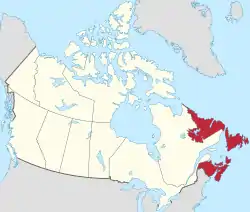 Atlantic Canada (red) within the rest of Canada | |
| Country | Canada |
| Provinces | |
| Area | |
| • Total | 500,531 km2 (193,256 sq mi) |
| Population (2016) | |
| • Total | 2,333,322 |
| • Density | 4.7/km2 (12/sq mi) |
History
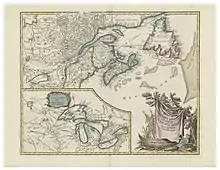

The first premier of Newfoundland, Joey Smallwood, coined the term "Atlantic Canada" when Newfoundland joined Canada in 1949. He believed that it would have been presumptuous for Newfoundland to assume that it could include itself within the existing term "Maritime Provinces," used to describe the cultural similarities shared by New Brunswick, Prince Edward Island, and Nova Scotia. The three Maritime provinces entered Confederation during the 19th century (New Brunswick and Nova Scotia were founding members of the Dominion of Canada in 1867, and Prince Edward Island joined in 1873).
Geography
Although Quebec has a physical Atlantic coast on the Gulf of St. Lawrence, it is generally not considered an Atlantic Province, instead being classified as part of Central Canada along with Ontario. Atlantic and Central Canada together are also known as Eastern Canada.
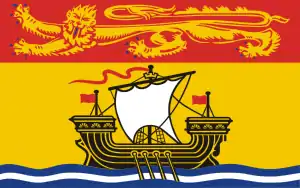
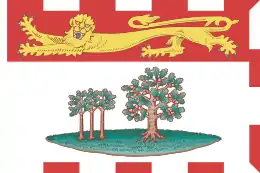

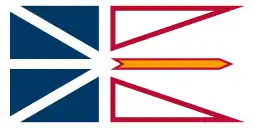
2016 census figures for "Metropolitan Areas" (broadest definition, includes entire municipalities and all commuter municipalities) and "Population Centres" (limited to actual continuously-built-up area) in Atlantic Canada. The list includes communities above 10,000, by Metropolitan Area population, or 5,000 by Population Centre population.
| Community | Province | Population (Metropolitan)[3] | Population (Pop. Centre)[4] |
|---|---|---|---|
| Halifax | Nova Scotia | 403,390 | 316,701 |
| St. John's | Newfoundland and Labrador | 205,955 | 178,427 |
| Moncton | New Brunswick | 144,810 | 108,620 |
| Saint John | New Brunswick | 126,202 | 58,341 – Saint John |
| 24,445 – Quispamsis-Rothesay | |||
| Fredericton | New Brunswick | 101,760 | 59,405 |
| Cape Breton | Nova Scotia | 98,722 | 29,904 – Sydney |
| 17,556 – Glace Bay | |||
| 12,823 – Sydney Mines | |||
| Charlottetown | Prince Edward Island | 69,325 | 44,739 |
| Truro | Nova Scotia | 45,753 | 22,954 |
| New Glasgow | Nova Scotia | 34,487 | 18,665 |
| Corner Brook | Newfoundland and Labrador | 31,917 | 19,547 |
| Bathurst | New Brunswick | 31,110 | 15,557 |
| Miramichi | New Brunswick | 27,523 | 11,329 – Chatham-Douglastown |
| Kentville | Nova Scotia | 26,222 | 12,088 |
| Edmundston | New Brunswick | 23,524 | 12,086 |
| Summerside | Prince Edward Island | 16,587 | 13,814 |
| Grand Falls-Windsor | Newfoundland and Labrador | 14,171 | 12,046 |
| Gander | Newfoundland and Labrador | 13,234 | 10,220 |
| Campbellton | New Brunswick | 10,411 | 6,883 |
See also
- Acadiensis, scholarly history journal covering Atlantic Canada
- Atlantic Provinces Chambers of Commerce
- List of regions of Canada
- Atlantic Northeast
References
- "Population and dwelling counts, for Canada, provinces and territories, 2016 and 2011 censuses – 100% data". Statistics Canada. 2017-02-08. Retrieved 2017-02-08.
- "Gross domestic product, expenditure-based, by province and territory". Stats Canada. Nov 9, 2016. Retrieved Feb 7, 2017.
- "Population and dwelling counts, for Canada, provinces and territories, census metropolitan areas and census agglomerations, 2016 and 2011 censuses – 100% data". Statistics Canada. Retrieved 8 February 2017.
- "Population counts, for census metropolitan areas, census agglomerations, population centres and rural areas, 2016 Census". Statistics Canada. Retrieved 8 February 2017.
Further reading
- Hamilton, William Baillie (1996), Place names of Atlantic Canada, University of Toronto Press, ISBN 0-8020-0471-7
- MacEachern, Alan Andrew (2001), Natural selections: national parks in Atlantic Canada, McGill-Queen's University Press, ISBN 0-7735-2157-7
- Martinez, Andrew J; Martinez, Candace Storm (2003), Marine Life of the North Atlantic: Canada to New England, Aqua Quest Publications, ISBN 1-881652-32-7
- Prieur, Benoit (2005), Atlantic Canada, Ulysse Travel Publ, ISBN 2894647239
External links
| Wikivoyage has a travel guide for Atlantic Provinces. |
| Look up Atlantic Canada in Wiktionary, the free dictionary. |